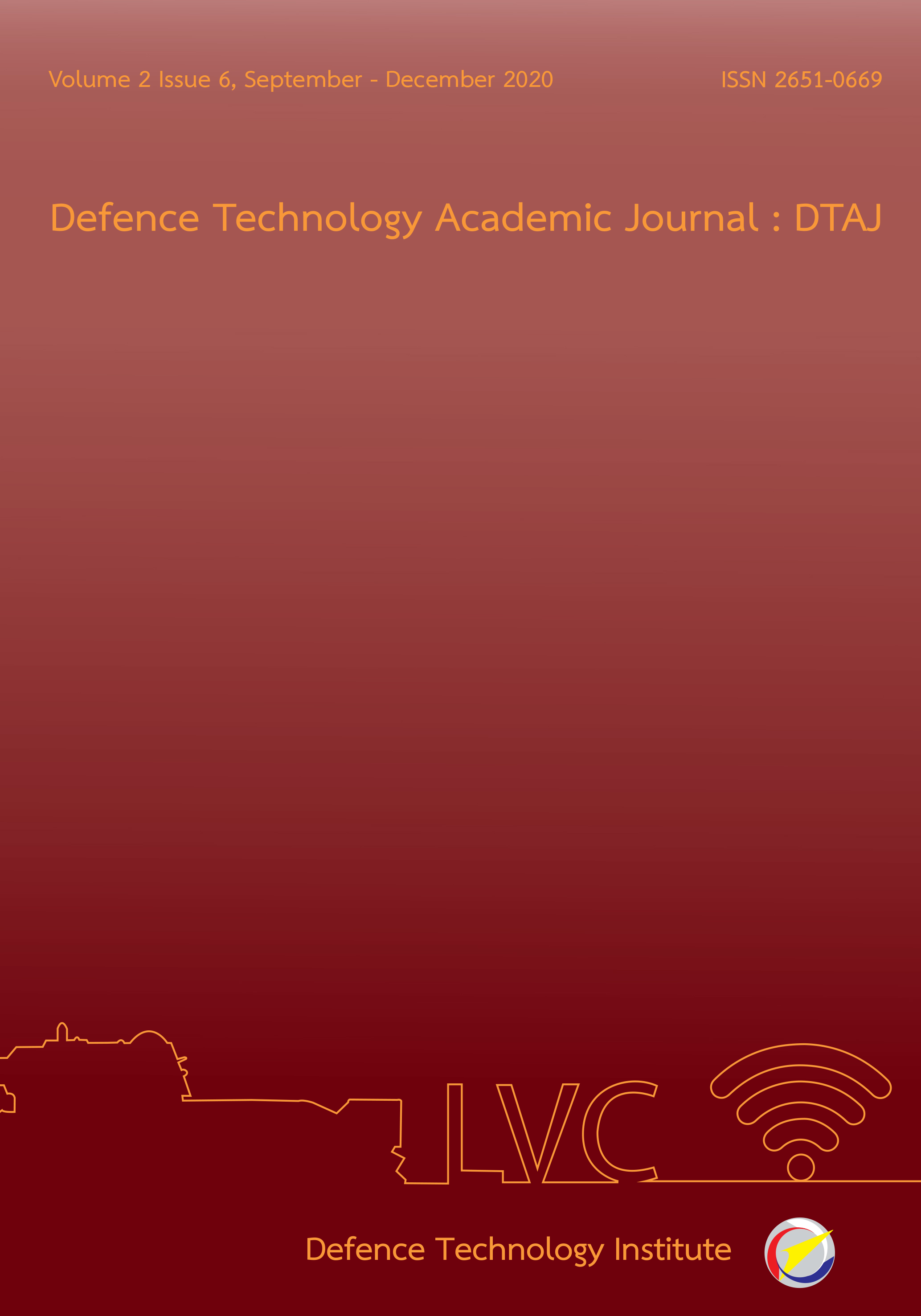Estimation of Land Surface Temperature by Derivative Analysis of MOD11A2 Product Data, MODIS System
Main Article Content
Abstract
This research was aimed to integrate approximation of Land Surface Temperature using value of derivative analysis retrieved from Terra Modis data of MOD11A2 product during 4 time periods years of 2004, 2008, 2013, and 2018, selecting Sakon Nakhon Province was chosen as study area. Terra Modis data Product MOD11A2 was used, which was in monthly format of the year 2004, 2008, 2013, and 2018, 48 data in total for the image processing approximate of Land Surface Temperature. The results showed that Land Surface Temperature data analyzed from the satellite data was similar to the Land Surface Temperature data obtained from Thai Meteorological Department. The correlation was performed using correlation method, it was discovered that the correlation coefficient R = 0.988 was very high. In addition, using the above data to analyze by the simple linear regression analysis, it was found that the coefficient of determination, R2 = 0.9774, meaning that the use of satellite data for this surface temperature analysis was reliable and the methodology in this study could be used to analyze surface temperatures in other areas of Thailand.
Downloads
Article Details

This work is licensed under a Creative Commons Attribution-NonCommercial-NoDerivatives 4.0 International License.
Journal of TCI is licensed under a Creative Commons Attribution-NonCommercial-NoDerivatives 4.0 International (CC BY-NC-ND 4.0) licence, unless otherwise stated. Please read our Policies page for more information...
References
Laosuwan, T., Gomasathit, T., & Rotjanakusol, T. (2017). Application of Remote Sensing for Temperature Monitoring: The Technique for Land Surface Temperature Analysis. Journal of Ecological Engineering, 18 (3), 53 - 60.
Dechaphongthana, W., Karnchanasutham, S., Nualchawee, K., & Intarawichian N. (2016). The Relationships between Land Surface Temperature and NDVI of Paddy Rice Areas in Stages of Growth from Satellite Data. Journal of Geoinformation Technology of Burapha University, 1 (2), 14 - 30.
Rotjanakusol, T., & Laosuwan, T. (2020). Model of Relationships between Land Surface Temperature and Urban Built-Up Areas in Mueang Buriram District, Thailand. Polish Journal of Environmental Studies, 29 (5), 3783 - 3790.
Rotjanakusol, T., & Laosuwan, T. 2018. Estimation of Land Surface Temperature using Landsat Satellite Data: A case study of Mueang Maha Sarakham District, Maha Sarakham Province, Thailand for the years 2006 and 2015. Scientific Review Engineering and Environmental Sciences, 27 (4): 401 - 409.
Mukhelif, A., Al.Ammar, K., & Al. Jooburi, M. (2016). The Seasonal Variation of the Urban Heat Island Effect and Estimating the Human – Discomfort Index at the City of Hillah. Pure and Applied Sciences, 24 (2), 423 - 434.
Mathew, A., Khandelwal, S., & Kaul, N. 2017. Investigating spatial and seasonal variations of urban heat island effect over Jaipur city and its relationship with vegetation, urbanization and elevation parameters. Sustainable Cities and Society, 35, 157 - 177.
Prohmdirek, T., Chunpang, P., & Laosuwan, T. (2020). The Relationship between Normalized Difference Vegetation Index and Canopy Temperature that Affects the Urban Heat Island Phenomenon. Geographia Technica, 15 (2), 222 - 234.
Lemke, P., Ren, J., Alley, R.B., Allison, I., Carrasco, J., Flato, G., Fujii, Y., Kaser, G., Mote, P.W., Thomas, R.H., & Zhang, T. (2007). Climate Change 2007: The Physical Science Basis. Contribution of Working Group I to the Fourth Assessment Report of the Intergovernmental Panel on Climate Change. Cambridge University Press, Cambridge, United Kingdom and New York, NY, USA.
Hally B., Wallace, L., Reinke, K., Jones, S., Skidmore A. (2018). Advances in active fire detection using a multi-temporal method for next-generation geostationary satellite data, International Journal of Digital Earth, 12 (9): 1030 - 1045.
Uttaruk, Y., & Laosuwan, T. (2018). Community Forest for global warming mitigation: the technique for estimation of biomass and Above Ground Carbon Storage using Remote Sensing method. Agriculture and Forestry, 64 (3), 47 - 57.
Uttaruk, Y., Laosuwan, T. (2020). Comparison of Carbon Storage Measurement Methods on Agroforestry Systems in Sakon Nakhon Province, Northeast Thailand. The Scientific Journal of King Faisal University, Basic and Applied Sciences, 21 (2), 95 - 99.
Rotjanakusol, T., & Laosuwan, T. (2020). Surface Water Body Extraction Using Landsat 8 Images and Different Forms of Physical Models. The Scientific Journal of King Faisal University, Basic and Applied Sciences, 21 (2), 218 - 223.
Ren, Huazhong., Du, Chen., Liu, Rongyuan., Qin, Qiming., Yan, Guangjian., Li, Zhao-Liang., & Meng, J. (2015). Atmospheric water vapor retrieval from Landsat 8 thermal infrared images. Journal of Geophysical Research Atmospheres, 120 (5), 1723 - 1738.
Yu, X., Guo, X., & Wu, Z. (2014). Land Surface Temperature Retrieval from Landsat 8 TIRS-Comparison between Radiative Transfer Equation-Based Method, Split Window Algorithm and Single Channel Method. Remote Sensing, 6 (10), 9829 - 9852.
Chen, F., Yang S., Su, Z., & He, B. (2015). A New Single-channel Method for Estimating Land Surface Temperature Based on The Image Inherent Information: The HJ - 1B case. ISPRS Journal of Photogrammetry and Remote Sensing, 101, 80 - 88.
Du, C., Ren, H., Qin, Q., Meng, J., & Zhao, S. (2015). A Practical Split-Window Algorithm for Estimating Land Surface Temperature from Landsat 8 Data. Remote Sensing, 7 (1), 647 - 665.
Chokkuea W. (2019). Spatial - temporal Change of Land Surface Temperature using Satellite Remote Sensing Data. Studia Universitatis “Vasile Goldis” Seria Stiintele Vietii (Life Sciences Series), 29 (2): 65 - 69.


